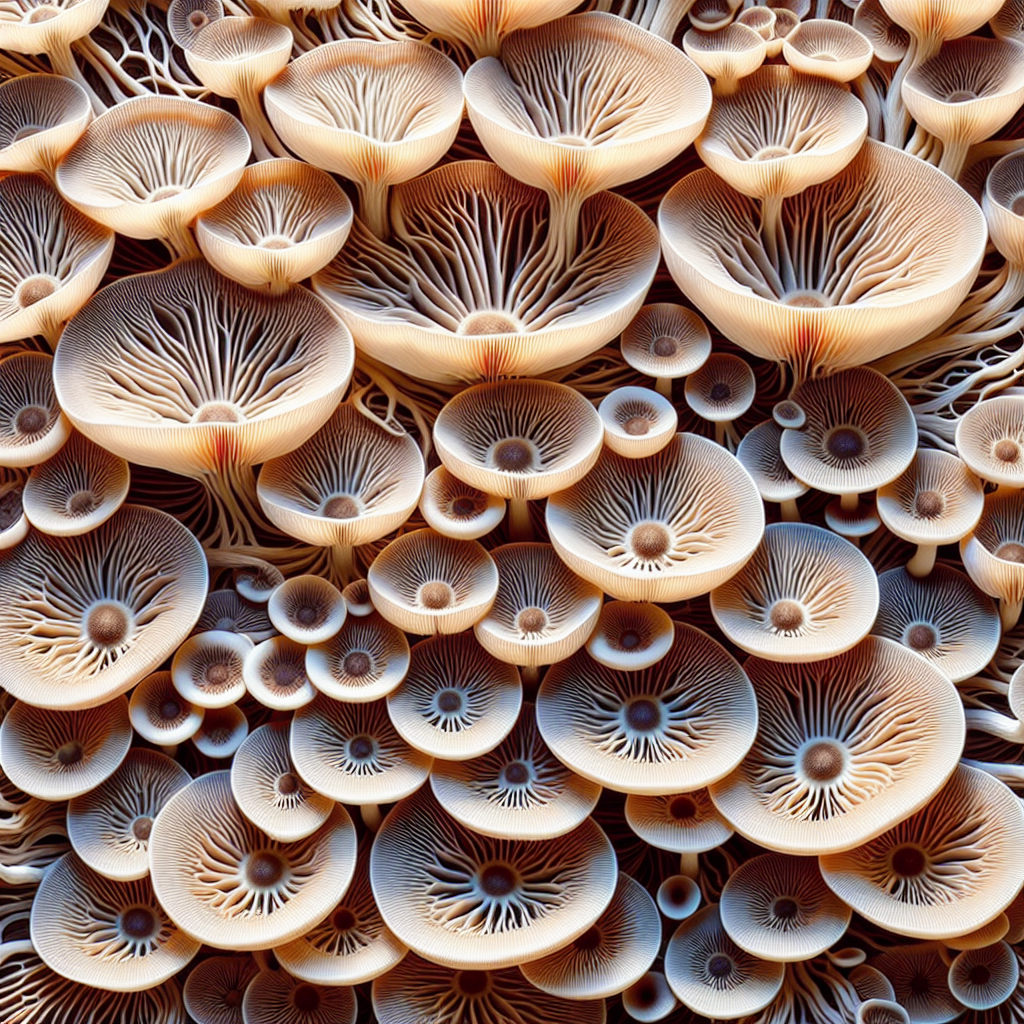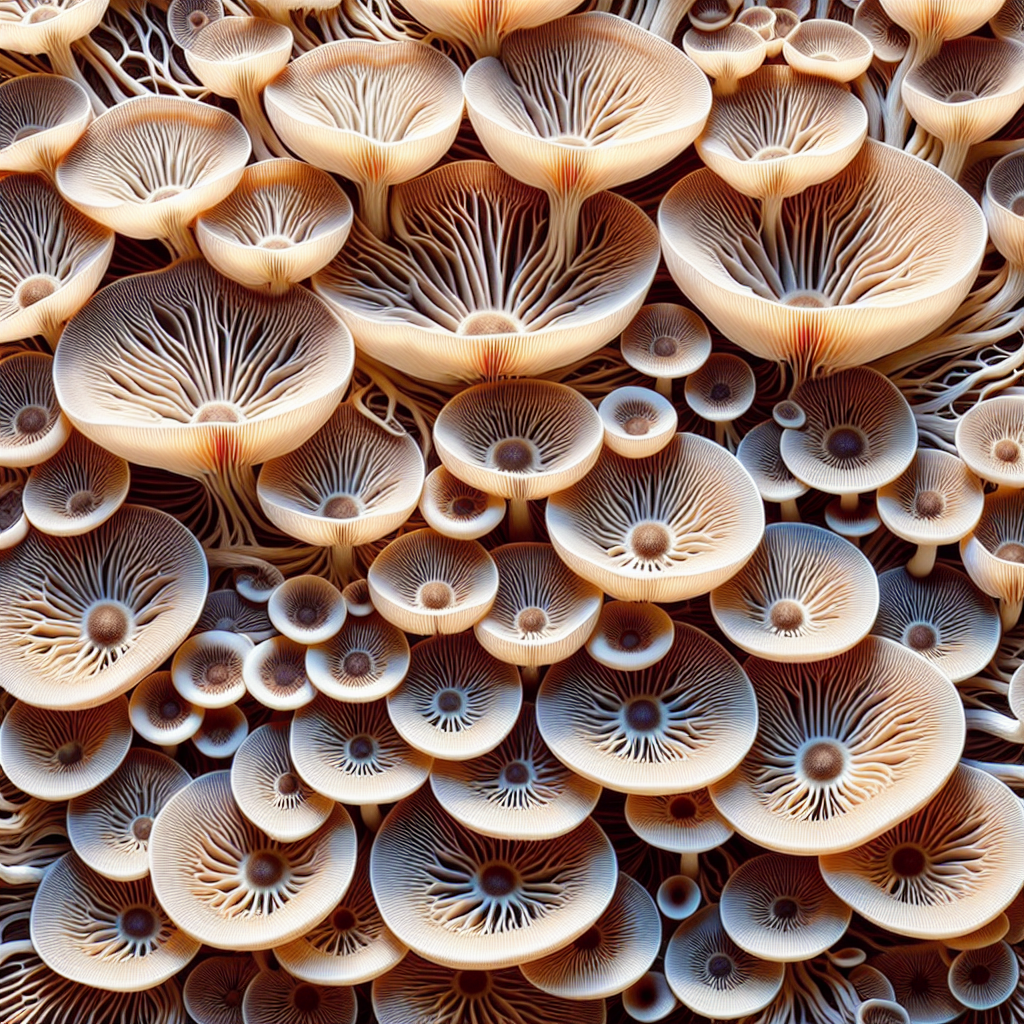In the comprehensive article, “Understanding the Oyster Mushroom mycelium growth Process,” you will explore the complex and fascinating progression of oyster mushroom mycelium development. This guide will demystify the biological mechanisms underlying mycelial growth and the cultivation of this highly nutritious and versatile edible fungus. By the end, you will have gained profound insights into the lifecycle of the oyster mushroom, providing you with a rich appreciation of this natural wonder.

Oyster Mushroom Mycelium Basics
Cultivating oyster mushrooms begins with gaining a clear understanding of the basics of oyster mushroom mycelium. The mycelium, in essence, is the fungal network that serves as the foundation for mushroom growth.
Definition and Overview of Mycelium
Mycelium refers to the white, thread-like network of cells (known as hyphae) of fungi, which is often found beneath the soil or within a substrate. It extends far beyond the visible fungus or mushroom; in fact, the mycelium forms the major part of the fungal organism and is responsible for nutrient absorption from the growth medium.
Role of Mycelium in Oyster Mushroom Lifecycle
In the lifecycle of the oyster mushroom, the mycelium plays the pivotal role of gathering nutrients required for the development of the mushroom’s fruiting body (the readily recognizable part of the mushroom). Essentially, the mycelium serves as the mushroom’s ‘root system,’ laying the groundwork for mushroom formations.
Distinguishing Features of Oyster Mushroom Mycelium
Even though mycelium may appear similar across many fungus species, each type has unique characteristics. Oyster mushroom mycelium is typically dense, fast-growing, and white, bearing a fluffy appearance. It’s also renowned for its resilience, being one of the few fungi that can consume wood and other tough organic materials.
Factors Influencing mycelium growth
A host of factors impact the growth rate and success of the oyster mushroom mycelium. Understanding these parameters can mean the difference between a successful mushroom crop and a failed one.
Temperature and Mycelium Development
mycelium of oyster mushrooms thrives within a specific temperature range, often between 20 to 28°C (68 to 82°F), which allows for optimal growth speed and health.
Humidity’s Role in Mycelium Growth
High humidity levels, typically over 85%, promote mycelium growth by providing an environment conducive to its expansion. Too low humidity can lead to the mycelium’s drying out and stunted growth, while extreme humidity might promote mold growth.
Effect of Light on Oyster Mushroom Mycelium
While the mycelium itself doesn’t require light for growth, the formation of fruit bodies of oyster mushrooms does depend on adequate light exposure. Hence, controlling light levels during different growth stages is crucial.
Substrate: Content and Quality
The quality, type, and preparation of the substrate directly influence mycelium growth. Oyster mushrooms are versatile and can grow on a variety of organic substances, such as straw, woodchips, and coffee grounds.
Steps in Mycelium Formation and Colonization
Oyster mushroom mycelium undergoes different stages of development before leading to mature mushrooms.
From Spores to Hyphae
The process begins with spores which, under right conditions, germinate and give rise to hyphae, the invisible fungal threads.
Hyphal Knot Formation
Multiple hyphae interlink to form hyphal knots, which are denser, visible clusters of mycelium. These knots signify the first sign of mushroom primordia.
Mycelial Mat Creation
These hyphal knots grow and eventually form a thick mat of mycelium, which covers the designated substrate surface, prepping for fruiting body development.

Optimizing Mycelium Growth Conditions
Creating an ideal environment for mycelium growth is essential to successful cultivation.
Ideal Temperature and Humidity
Maintaining an environment with a temperature between 20 to 28°C and a humidity level above 85% ensures the best conditions for mycelium growth.
Substrate Preparation for Optimal Growth
The substrate should be adequately hydrated and sterilized to prevent contamination and provide a conducive environment for mycelium propagation.
Controlling Light Exposure
The mycelium stage of mushroom growing does not require light. However, transition to the fruiting stage demands controlled light exposure.
Recognizing Healthy Mycelium Growth
Monitoring and understanding the signs of a healthy mycelium are key to successful cultivation.
Observation and Monitoring of Mycelium Growth
Close and regular observations enable you to recognize and address any signs of abnormal growth promptly.
Identifying Healthy Mycelium Characteristics
Healthy oyster mushroom mycelium is dense, white, and expands quickly across the substrate surface.
Signs of Unhealthy or Stalled Mycelium Growth
Stagnant growth, discoloration, and unusual odors often indicate an issue with the mycelium, which could stem from contamination or improper growth conditions.
The Role of Nutrients in Mycelium Growth
Nutrients serve as the lifeline for robust and prolific mycelium growth.
The Importance of a Nutrient-Rich Substrate
Oyster mushroom mycelium requires a variety of nutrients, which should be provided in the substrate for the mycelium to extract.
Specific Nutrients Required by Mycelium
The main nutrients required include carbon, nitrogen, and trace elements such as potassium, calcium, and magnesium, which aid in enhancing the mycelium’s health and productivity.
The Impact of Nutrient Deficiency
A lack of essential nutrients can lead to stunted mycelium growth, lower productivity, and weakened immunity against contaminants.
Mycelium Growth Stages and Fruitbody Formation
Physiological changes in mycelium mark the progression to fruit body formation.
From Mycelium to Primordia
Once fully colonized, the mycelium undergoes another transformation as dense clusters of mycelium start to form primordia, the initial stage of the fruiting body.
Formation of the Early Fruiting Body
Emerging from the primordia, tiny, not-yet-fully-formed mushrooms, or “pins,” begin to appear. These early fruit bodies eventually mature into mushrooms.
Stages of Fruiting Body Maturation
Following the pinning stage, the mushroom heads start to grow and expand, maturing into the recognizable oyster mushroom form.
Dealing with Contamination in Mycelium Growth
Managing contamination forms a significant part of the hurdle in growing mycelium.
Common Contaminants During Mycelium Growth
Mycelium growth is often threatened by contaminants such as molds, bacteria, yeasts, and other fungi, which can inhibit growth or cause diseases.
Preventing Contamination in the Growth Environment
Adherence to sterile procedures, proper preparation and storage of substrate, and maintaining an optimal growth environment are key to avoiding contamination.
Handling Contamination When It Happens
If contamination occurs, you must isolate and remove the affected parts promptly to prevent it from spreading.
Techniques to Enhance Mycelium Proliferation
Certain advanced techniques can help encourage mycelium growth.
Advanced Techniques for Mycelium Optimization
These may include maintaining optimal conditions, making the right substrate choice, and introducing nurturing additives to bolster mycelium growth.
Creating a Stress-Free Environment for Growth
Giving mycelium the right environment to grow stress-free, that is, without temperature fluctuations, humidity drops, or light disturbances, can considerably enhance its growth.
Utilizing Nutrition Enhancers
In addition to the regular nutrient supply from substrates, you can employ nutrient-rich supplements to make sure your mycelium has everything it needs for a healthy expansion.
Common Problems with Oyster Mushroom Mycelium
Numerous issues can potentially arise during mycelium growth, which need to be addressed promptly.
Diagnosing Common Mycelium Health Issues
Typical problems include contamination, improper nutrient supply, and environmental stressors, which can be detected through regular observation and monitoring.
Treatment and Recovery Strategies
Depending on the issue, strategies such as removing contaminated areas, adjusting environmental conditions, or providing additional nutrients may be employed.
Ways to Prevent Common Problems
Preventing problems with mycelium growth mainly involves maintaining optimal growth conditions, using well-prepared substrate, and adhering to sterile cultivation practices.
